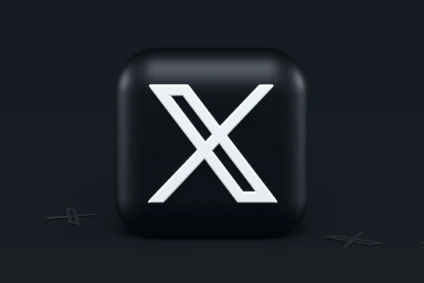
This article was co-written by David Barnett and Ernie Bell.
It is fair to say that Elon Musk’s rebranding of Twitter as ‘X’ (announced on Monday 24 July 2023) – attempting to reimagine it as a ‘super app’ analogous to Tencent’s WeChat[1] – has not gone smoothly. From a purely practical point of view, the removal of the physical lettering from the headquarters in San Francisco was interrupted by police when it emerged that appropriate permissions had not been sought, leaving the building just reading ‘er’[2].
Conventional wisdom (rightly) dictates that a new brand name should ideally be novel and distinctive. This not only aids with the acquisition of relevant intellectual property protection, but also makes the subsequent process of monitoring for, and enforcing against, brand infringements much more straightforward. The new X brand is neither of these things, with even the logo itself appearing very similar to a standard Unicode[3] digital character[4],[5] (Figure 1). The Executive Creative Director at Monotype (the font-set in question) has publicly commented that Musk’s ‘X’ is not taken from their ‘Special Alphabets 4’[6],[7]; however, it would have been a risky strategy to not to do proper due diligence and clear this matter with Unicode prior to launch. Elon Musk had asked his followers to find an ‘X’ logo “good enough” to rebrand Twitter[8] and they obliged. This type of ‘crowdsourcing’ is definitely not the recommended way of creating the intellectual property which a brand owner intends to use as the public face of their organisation. Many questions arise as to ownership, use, goodwill, royalties, rights of enforcement and the many more legal challenges which can result from using someone else’s intellectual property.
|
|
|
Figure 1: The new profile page for Twitter / X (left), and a description page for Unicode character U+1D54F (right).
Furthermore, in IP parlance, a single letter has ‘no semantic content’. Nevertheless, this has not prevented a number of ‘domain brokers’ and other speculators from attempting to take advantage of the buzz and monetise a range of Internet assets – even those which are apparently totally irrelevant – containing the ‘x’ (Figure 2).

Figure 2: Example of a posting by a domain broker attempting to monetise (purportedly) X-related domain names.
The situation is further complicated by the fact that a number of other companies – including Meta and Microsoft – already have intellectual property rights covering the same letter (relevant to the Xbox brand in the latter case), with over 900 active US trademarks already registered, making it unclear how Twitter / X might be able to defend this brand[9],[10].
It is also important to bear in mind that the Twitter brand has a great deal of legacy familiarity and goodwill associated with it, which Musk risks losing– with associated damage to brand value– following the renaming[11].
Beyond this, the online landscape is – frankly – a mess. The launch of a new brand should generally be preceded by the acquisition of relevant online ‘real estate’ (potentially anonymously, to avoid the pre-emptive leakage of information relating to the brand’s identity). The relevant content might include domain names – both ‘core’ domains to be used for the general infrastructure of the website and business, and ‘strategic’ domains comprising defensive registrations and names to be used for future extensions of the business– and other relevant assets, such as social-media profiles.
However, at the time of launch, Twitter was not even in possession of the @x username on its own platform, subsequently seizing it from its long-term owner without warning or compensation[12]. Of course, social media sites make it very clear that they have the right to revoke username handles at any time, but this example could set a concerning precedent for other sites to do the same, as and when they may choose to rebrand. We note that, three days after the supposed brand launch, Twitter / X has not rebranded its official presence on the Meta platforms Facebook and Instagram, which may cause some brand confusion. Additionally, the main corporate website was also showing a confusing mix of branding (Figure 3), and the mobile app was still branded as Twitter.

Figure 3: The desktop log-in page of Twitter / X as of 27 July 2023.
Additionally, as of the day of launch, the x.com domain– despite having been acquired by the organisation– had not seen the relevant DNS changes successfully propagated across the Internet, meaning that many users were seeing just a GoDaddy parking page featuring sponsored ads for third-party websites and services. It has also been noted that a number of other relevant domain names– including examples such as xsafety.com, which could potentially be confused with official Twitter / X sites– are currently owned by third parties or listed for sale[13]. Beyond these, any unregistered relevant domain names are ripe for purchase by cybersquatters, who may attempt to sell them back to the official corporation, or by other bad actors for phishing, malware distribution, brand impersonation or other types of attack or infringement.
Indeed, zone-file analysis of the set of .com domains only (the most popular domain extension by a significant margin)[14], and considering only domains with ‘x’ at the start, gives some indication of the scale of the problem. As of 27 July 2023 (three days after Twitter’s rebrand), the .com zone file contains around 1.04 milllion registered domain names beginning with ‘x’ (excluding internationalised domain names, which are encoded as (Punycode) strings beginning ‘xn--’). Of these, around 6,500 were not present in the zone file on 21 July (three days before the rebranding) and have therefore been registered in the intervening six-day period. Of course, many of these are clearly unrelated to the Twitter / X brand, but many do feature keywords suggesting that they may have been registered with the rebranding in mind– to take advantage of the online buzz, misdirect users, or to cybersquat– or could be confused with domains falling into these categories.
At least 300 new domains were found to be of potential high relevance, including examples featuring keywords such as ‘app’, ‘download’, ‘musk’, ‘coin’, ‘invest’, ‘help’ or ‘service’. Of these, around one in five were found to have active MX (mail exchange) records, indicating that they have been configured to be able to send and receive e-mails and– even in the absence of any live site content– could potentially be associated with phishing activity.
Furthermore, however, many of the high-relevance domains were found already to resolve to live websites, including several examples which appear potentially to be infringing against the X brand, and some which may be associated with active scams. Some examples are shown in Figure 4.
|
i. |
|
ii. |
|
|
iii. |
|
iv. |
|
|
v. |
|
vi. |
|
|
vii. |
|
viii. |
|
Figure 4: Examples of potentially infringing new domain registrations relating to the X brand
(i: xcoinerc[.]com; ii: x-coin-x[.]com; iii: xdogeeth[.]com; iv: xelonerc[.]com; v: xbluetoken[.]com;
vi: xpay-project[.]com; vii: xmoontoken[.]com; viii: xwifecoin[.]com).
The experiences surrounding the X rebrand illustrate a number of key points an organisation should bear in mind when considering the launch of a new brand name. Some of the most significant lessons include:
- Select the brand name carefully, and ideally choose one which is distinctive and not under prior use by third parties. Marks which are more distinctive generally afford greater degrees of protection.
- Ensure that IP rights are protected through the registration of appropriate trademarks in relevant classes and jurisdictions. Although rights generally arise through the use of a mark in the course of trade, applications can be submitted on the basis of intention to use.
- Ensure that key online assets – including branded domain names and social-media profile handles – are acquired, available for use, and configured correctly.
- Following the launch of the brand, continued proactive ongoing monitoring for infringements, and enforcement against concerning content, is crucial.
[1] https://www.cnbc.com/2023/07/26/elon-musks-x-rebrand-reignites-goal-to-turn-twitter-into-chinas-wechat.html
[2] https://www.theguardian.com/technology/2023/jul/25/elon-musk-x-rebrand-twitter-sign-removal
[4] https://www.hitc.com/en-gb/2023/07/25/twitters-mathematical-double-struck-capital-x-logo-mocked-for-unicode-resemblance/
[5] https://twitter.com/EliotHiggins/status/1683427725892042753
[6] https://www.ft.com/content/da262b2a-f39a-466b-9b2f-2f8fa84f0117
[7] https://www.businessinsider.com/elon-musk-made-new-x-twitter-logo-says-will-change-again-2023-7
[8] https://www.theverge.com/2023/7/26/23809087/elon-musk-x-logo-twitter-trademark
[9] https://www.reuters.com/technology/problem-with-x-meta-microsoft-hundreds-more-own-trademarks-new-twitter-name-2023-07-25/
[10] https://www.cbsnews.com/news/twitter-trademark-x-com-rebrand/
[11] https://www.linkedin.com/posts/vaibhavsisinty_elon-musk-just-killed-twitter-he-is-rebranding-activity-7089862486773956608--uJy
[12] https://techcrunch.com/2023/07/26/twitter-now-x-took-over-the-x-handle-without-warning-or-compensating-its-owner/
[13] https://www.forbes.com/sites/barrycollins/2023/07/24/the-x-rated-problem-with-twitters-new-name-for-millions-of-users/
[14] https://research.domaintools.com/statistics/tld-counts/

















